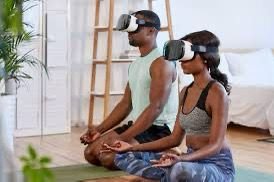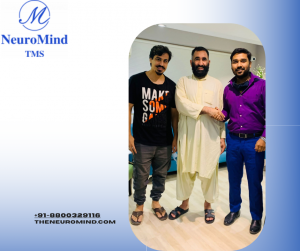VR Therapy
VR therapy uses virtual worlds and scenarios as a therapeutic tool. A person may wear a headset or use a device to immerse themselves in the virtual world and interact with it.
It is possible to simulate a wide variety of worlds and scenarios with VR, which makes it useful for constructing situations that are hard to recreate in real life or that could be too scary or risky.
Therapists may use VR to allow clients to practice real-life challenges, revisit a past event, or help a person confront their fears in a controlled environment.
Researchers published the first paper on VR therapy over 25 years ago, but as the technology has improved, interest in this therapeutic tool has increased.




How Does VR Therapy Work?
VR therapy works by allowing people to act out, practice, or revisit situations in a safe environment. This may:
- Teach skills
- Reduce fears
- Improve confidence
- Help process something that happened in the past
- By removing real-world risks, VR can also make something frightening feel more manageable.
For example, a person with a phobia may not be ready to confront it in reality. Interacting with a simulation in VR may help them gradually become accustomed to the object of their fear and learn it is not a threat.
In this way, VR may help bridge the gap between therapy and the real world.
Virtual Reality Treatment for Mental Health at NeuroMind
The road to mental health is working towards expanding the scope and in-depthness of traditional treatment methods, where new technology is seamlessly merged. Neuromind stands triumphantly over this global change, promoting a cutting-edge approach through the synergies between Transcranial Magnetic Stimulation (TMS) and Virtual Reality experiences. Searching for a new therapy, we will try to understand how Neuromind is changing mental health care using Virtual Reality (VR).
What is Virtual Reality?
It is understood under mental health VR for mental health as virtual reality technology that is used in the medical realm, particularly for mental health issues, to resolve them and for the promotion of wellness. It sets up virtual environments and simulations as tools designed to offer controlled and organized experiences to those who will use them to combat mental health issues.
In virtual reality, VR therapy for depression uses VR headsets or devices to make the individual feel like they are in computer-generated environments, which are simulations of real-life situations. Customizing these virtual worlds to achieve specific remedial objectives, namely, exposure to phobias, interventions for anxiety or depression, or stress reduction exercise by relaxation, is also possible.
Advantages Of Virtual Reality Therapy for Mental Health Treatment:
Exposure Therapy:
Virtual reality users can face their feared objects or difficult situations repeatedly until they start overcoming them via feelings and senses they get from such a controlled and secure environment. This technique is beneficial for the treatment of fears, PTSD, and also anxiety disorders.
Skill Building:
The VR simulations created by the computer enable clients to explore their coping skills, social interactions, and emotion management using scenarios nearly identical to real-life situations. It could be considered the primary method as people can master the art of being in therapy.
Enhanced Engagement:
With the advancement of VR, it has become so real that it can take the person’s mind and get him involved in psychological therapy that will motivate him and become a part of the VR treatment process.
Personalized Treatment:
VR may be modified to meet a wide range of needs and supply a particular intervention for each person in VR during treatment. Besides that specific fact, immersive tech brings an individualized taste.
Accessible and Flexible:
VR therapy transfers to various settings, including outpatient facilities, hospitals, and even the remote platform via teletherapy application. This also provides mental health care access to a broader population, serving people who can’t travel or prefer having a teletherapy session.
Unveiling NeuroMind: Structuring New Model of Mental Health Treatment
Neuromind is a new player in the area of mental health therapy, which provides a comprehensive solution, avoiding the standard approaches and focusing on the primary reasons behind mental health disorders. By TMS (a non-invasive treatment with the aid of VR technology that hyper focuses on specific brain regions), Neuromind possesses VR technology that not only stimulates the brain to improve its capacity but also brings about a remarkable turnaround in health.
Immersive Experiences Redefined: The Core
The core of the brain’s neuroscience center of Neuromind is Virtual Reality (VR) therapy, a unique method of various treatments that takes people to virtual scenes of their needs. VR therapy, even absent the limits of the physical universe, liberates a plethora of personal case options, and therapists can attend to the needs of their patients in a safe and patient-centric setting.
Working of VR Therapy:
While belonging to the domain of virtual reality therapy psychology, virtual reality treatment uses fully immersive virtual environments for therapies and psychotherapy encounters and for coping with particular psychological problems.
● Creating Immersive Environments:
Virtual reality therapy uses virtual reality technology to produce virtual reality, which, unlike other therapies, allows the patient to experience simulated and realistic conditions. Virtual reality technology can copy natural scenery to create a pleasant scene where the patient’s treatment goal is fitted.
● Engagement and Presence:
Users would attach VR headsets/devices to enter (virtual) reality worlds. Virtual reality technology is so powerful that when put on the VR headset, it creates a sense that the person is in the virtual space in such a way that the person feels like they are there.
● Therapeutic Interventions:
Virtual reality can be a supplement to traditional psychiatric methods by employing individualized techniques according to a unique psychotherapy style for each patient. Here, some examples are given: desensitization techniques for phobias and PTSD, cognitive-behavioral methods for anxiety and depression, and mindfulness for stress, which are very helpful.
● Integration with Traditional Therapy:
VR therapy incorporates traditional therapeutic methods (CBT). The latter methods include cognitive-behavioral therapy and VR exposure therapy. The platform serves as a natural addition to talking therapy while giving the occasion for changing the behavior and conducting the consequential behavior.
VR Therapy for Mental Health:
VR therapy takes psychotherapy to a higher level than what was experienced in the past as a powerful platform for people to avail themselves of the treatment of different psychiatric illnesses. For example, VR therapy for PTSD (Post-traumatic stress disorder) help patients overcome phobia; therefore, it improves emotional health and strengthens psychological resistance. Through virtual reality experience, individuals are brought to meet with fake environments that are contrived to expose them to the practice of exposure, skill therapy, and emotional scenarios that help them to underground and internalize the profound discoveries culminating in perpetual transformation.
A Closer Look at Neuromind: A Closer Look at NeuroMind
The Neuromind endeavors to use virtual reality (VR) with its programs to enable a VR treatment approach by which patients can take part in an immersive experience whose inclination or tendency augments the therapeutic process, making it more effective. A patient can make tailor-made VR sessions that specially address disorders and issues and the set of goals and purposes. It doesn’t matter if you are not at the point where you are capable of standing still in the presence of dying people, if you are practicing ways to cope with challenging situations or, regardless.
What kind of ailments can VR aid?
The present body of research is proving that VR therapy may be effective in treating diverse mental health problems.
● Phobias:
The benefit of VR therapy is that it is effective in addressing specific phobias such as acrophobia, aviophobia, arachnophobia, or agoraphobia.
● Post-Traumatic Stress Disorder (PTSD):
VR therapy for PTSD showed positive response through the creation of Virtual reality simulations in which the traumatic situation is recreated or a traumatizing environment.
● Social and Emotional Skills:
VR therapy allows people to apply and perfect their social and emotional skills, e.g., communication effectiveness, self-advocacy, empathy, and emotional control.
● Anxiety and Depression:
VR therapy can eliminate or reduce symptoms of anxiety and depression through interactive and multi-sensory experiences.
The Promise of VR Therapy: Opening the Window of Opportunities
The TMS NeuroMind now opens new horizons of virtual reality therapy in existing mental health care. VR leads to that level of self-realization, guts, and empowerment, an unprecedented experience that allows people to reach. Due to the ease of VR therapist’s office and home-based interventions, Neuromind healing through VR shows better flexibility and accessibility regarding mental health.
As for the fluid nature of the mental health care industry, Neuromind is a giver of hope and innovation. In addition, Neuromind features VR therapy that provides them with an inclusive package to experience the efficacy and empowerment of customized treatment. Every session becomes a voyage for improvement, the discovery of the human mind’s possibilities, and its ultimate path to psychological well-being.
Join the Revolution: Get Started Now with Neuromind.
Travel the path to mental well-being with Neuromind devices. Discover the miraculous potential of VR therapy and the boundless mental performance without limits. MNT, the future of mental health care, is already in our grasp. Start your “tomorrow” immediately with a visit to our clinic and witness the power of Neuromind.
Frequently Asked Questions (FAQs)
We have submitted a FAQs list that people always ask us
How does TMS therapy work
How much does TMS therapy cost in Delhi?
What are the side effects of TMS therapy?
Video Testimonials by Patient
Testimonials by Patient










With access to
24 Hour
APPOINTMENT
Assistance
Our 24-hour appointment is available for everyone whenever urgent situations arise. Get essential care even during evenings, weekends, holidays, or other non-standard times.



